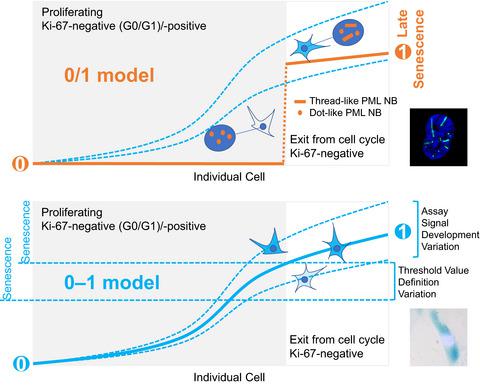当前位置:
X-MOL 学术
›
Aging Cell
›
论文详情
Our official English website, www.x-mol.net, welcomes your feedback! (Note: you will need to create a separate account there.)
PML2-mediated thread-like nuclear bodies mark late senescence in Hutchinson-Gilford progeria syndrome.
Aging Cell ( IF 7.8 ) Pub Date : 2020-04-29 , DOI: 10.1111/acel.13147 Ming Wang 1, 2, 3 , Lulu Wang 3 , Minxian Qian 1, 2 , Xiaolong Tang 1, 2 , Zuojun Liu 1, 2 , Yiwei Lai 3 , Ying Ao 1, 2 , Yinghua Huang 3 , Yuan Meng 1, 2 , Lei Shi 1, 2 , Linyuan Peng 1, 2 , Xinyue Cao 1, 2 , Zimei Wang 1, 2, 4 , Baoming Qin 3 , Baohua Liu 1, 2, 4, 5
Aging Cell ( IF 7.8 ) Pub Date : 2020-04-29 , DOI: 10.1111/acel.13147 Ming Wang 1, 2, 3 , Lulu Wang 3 , Minxian Qian 1, 2 , Xiaolong Tang 1, 2 , Zuojun Liu 1, 2 , Yiwei Lai 3 , Ying Ao 1, 2 , Yinghua Huang 3 , Yuan Meng 1, 2 , Lei Shi 1, 2 , Linyuan Peng 1, 2 , Xinyue Cao 1, 2 , Zimei Wang 1, 2, 4 , Baoming Qin 3 , Baohua Liu 1, 2, 4, 5
Affiliation

|
Progerin accumulation disrupts nuclear lamina integrity and causes nuclear structure abnormalities, leading to premature aging, that is, Hutchinson–Gilford progeria syndrome (HGPS). The roles of nuclear subcompartments, such as PML nuclear bodies (PML NBs), in HGPS pathogenesis, are unclear. Here, we show that classical dot‐like PML NBs are reorganized into thread‐like structures in HGPS patient fibroblasts and their presence is associated with late stage of senescence. By co‐immunoprecipitation analysis, we show that farnesylated Progerin interacts with human PML2, which accounts for the formation of thread‐like PML NBs. Specifically, human PML2 but not PML1 overexpression in HGPS cells promotes PML thread development and accelerates senescence. Further immunofluorescence microscopy, immuno‐TRAP, and deep sequencing data suggest that these irregular PML NBs might promote senescence by perturbing NB‐associated DNA repair and gene expression in HGPS cells. These data identify irregular structures of PML NBs in senescent HGPS cells and support that the thread‐like PML NBs might be a novel, morphological, and functional biomarker of late senescence.
中文翻译:

PML2介导的线状核体标志着Hutchinson-Gilford早衰综合症的晚期衰老。
早春素的积累会破坏核层的完整性,并导致核结构异常,导致过早衰老,即Hutchinson-Gilford早衰综合征(HGPS)。尚不清楚核小室(例如PML核小体(PML NBs))在HGPS发病机理中的作用。在这里,我们证明了经典的点状PML NBs在HGPS患者成纤维细胞中重组为线状结构,并且它们的存在与衰老的后期有关。通过免疫共沉淀分析,我们表明法呢基Progerin与人PML2相互作用,这解释了线程状PML NB的形成。具体而言,人类PML2而非HGPS细胞中的PML1过表达促进了PML线的发育并加速了衰老。进一步的免疫荧光显微镜,immuno-TRAP,深度测序数据表明,这些不规则的PML NB可能通过干扰NB相关的DNA修复和HGPS细胞中的基因表达来促进衰老。这些数据确定了衰老的HGPS细胞中PML NBs的不规则结构,并支持线状PML NBs可能是晚期衰老的一种新颖的,形态学的和功能性的生物标记。
更新日期:2020-04-29
中文翻译:

PML2介导的线状核体标志着Hutchinson-Gilford早衰综合症的晚期衰老。
早春素的积累会破坏核层的完整性,并导致核结构异常,导致过早衰老,即Hutchinson-Gilford早衰综合征(HGPS)。尚不清楚核小室(例如PML核小体(PML NBs))在HGPS发病机理中的作用。在这里,我们证明了经典的点状PML NBs在HGPS患者成纤维细胞中重组为线状结构,并且它们的存在与衰老的后期有关。通过免疫共沉淀分析,我们表明法呢基Progerin与人PML2相互作用,这解释了线程状PML NB的形成。具体而言,人类PML2而非HGPS细胞中的PML1过表达促进了PML线的发育并加速了衰老。进一步的免疫荧光显微镜,immuno-TRAP,深度测序数据表明,这些不规则的PML NB可能通过干扰NB相关的DNA修复和HGPS细胞中的基因表达来促进衰老。这些数据确定了衰老的HGPS细胞中PML NBs的不规则结构,并支持线状PML NBs可能是晚期衰老的一种新颖的,形态学的和功能性的生物标记。



























 京公网安备 11010802027423号
京公网安备 11010802027423号